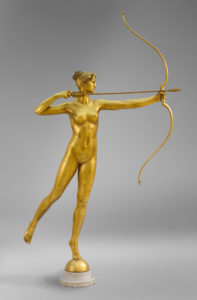 Coming on the heels of the redesign of its Charles Englehard Court, the Metropolitan Museum’s show of Augustus Saint-Gaudens makes perfect sense. After all, it’s his golden archer “Diana the Huntress,” poised high above the floor, that is the icon and resident muse of this new space.
Coming on the heels of the redesign of its Charles Englehard Court, the Metropolitan Museum’s show of Augustus Saint-Gaudens makes perfect sense. After all, it’s his golden archer “Diana the Huntress,” poised high above the floor, that is the icon and resident muse of this new space.
Saint-Gaudens (1848–1907) was the greatest American sculptor of his day, famous for masterpieces of public sculpture in New York, Boston, Chicago and other cities. If you’ve spent any time walking in Manhattan, you’ve probably passed his equestrian statue of Civil War General William Tecumseh Sherman at the southeast corner of Central Park. Sherman, riding high in the saddle, is led by winged Victory who strides ahead of the flinty general with upraised arm. The gilded bronze of the grouping glints brilliantly in the sunlight.
Perhaps you’ve seen it but can’t quite remember it.
That’s the problem Saint-Gaudens is up against with contemporary audiences. These memorials, for all their grandness and brilliance, are the kinds of things that only tourists with Michelin guides actually look at. The rest of us tend to see a generalization: military hero on horseback. We know there’s a lesson or a patriotic message involved, so our eyes glaze over.
A show like this, with its photomurals, bronze studies and reductions, gets the focus back on Saint-Gaudens sculpture – as art, rather than history lesson. The exhibit is organized chronologically, which is to say, biographically. Saint-Gaudens had a compelling rags-to-riches life story, the son of a French father and an Irish mother who immigrated to New York City when he was an infant. He was apprenticed at 13 to a cameo cutter, beginning his sculpture career at the smallest of scales, carving seashells into elegant brooches, pendants and bracelets. Usually these faces were rendered in profile, but in the first year of his apprenticeship, Saint-Gaudens showed his precocious ability with a more challenging three-quarter view.
By 1867, Saint-Gaudens was off to study in Paris. Three years later, with the outbreak of the Franco-Prussian War, he moved on to Rome. There, with examples of works by Michelangelo and Bernini before him, he learned the challenging craft of carving in marble, producing copies of antique heads – Cicero, Demosthenes – for the tourist trade. He went on to apply his skills to original marble works, the best known of which is his brooding “Hiawatha,” the Iroquois Indian immortalized in the Longfellow poem ( “By the shores of Gitche Gumee…”) Like “Diana,” “Hiawatha” is out in the sculpture court. It draws its artistic force from the depiction of a powerful body in a state of repose. That same idea, of strength at rest, can be seen in another piece in the court, the grand “Vanderbilt Mantelpiece,” the slab of which is held up by his two drowsy caryatids, “Amor” and “Pax.”

Bronze, not marble, proved to be Saint-Gaudens’ metier. For nearly a half-century after the end of the Civil War, American cities commissioned memorials to their lost sons, and cast bronze filled this need. Saint-Gaudens breakthrough work is his statue for Manhattan’s Madison Square Park of Union Admiral David Glasgow Farragut, best remembered for saying: “Damn the torpedoes. Full speed ahead!”
He also excelled at sculptural relief, a technique that harks back to his early cameo work. It is the closest the sculpture medium comes to painting. On view is a charming portrait of Scottish author Robert Louis Stevenson, who modeled for Saint-Gaudens during a visit to New York in 1887. It shows him writing in bed, knees propped up and – despite his tuberculosis — holding a cigarette in his other hand.
The show is good at showing the evolution of likenesses of famous subjects. In the case of Abraham Lincoln, you can see a bronze cast of a life mask made by Leonard Wells Volk in 1860, which Saint-Gaudens used for his “Standing Lincoln.” Saint-Gaudens used photographs to alter the face to resemble the creased, more somber Lincoln at the end of his life. Out of this larger statue came a smaller head, a number of which were cast in bronze and sold by his wife, Augusta, after his death.
For his famed “Shaw Memorial” on Boston Commons, which memorializes the African-American soldiers of the 54th Massachusetts Regiment, you can see the individual heads of four black soldiers, studies in which Saint-Gaudens left the left side of the face in rougher form, since only the right side would be seen in relief.
And, if you’ve ever wondered who modeled for the lithe “Diana,” a larger version of which once stood atop Madison Square Garden as a weathervane, it was Saint-Gaudens’ model and mistress, Davida Johnson Clark whose plaster portrait is a near twin of the head of Diana.

